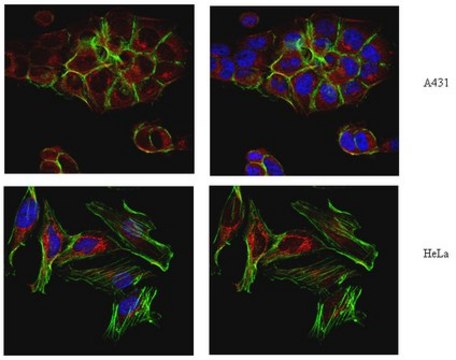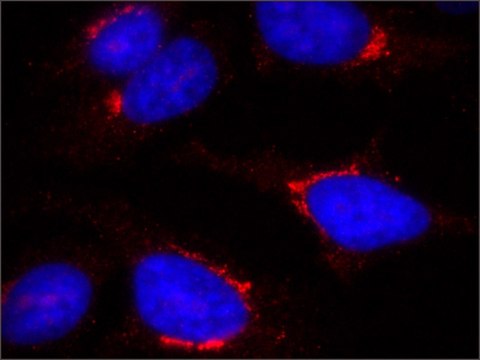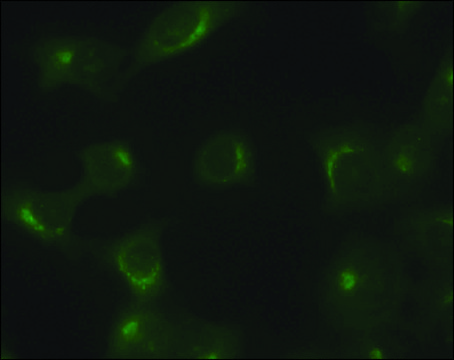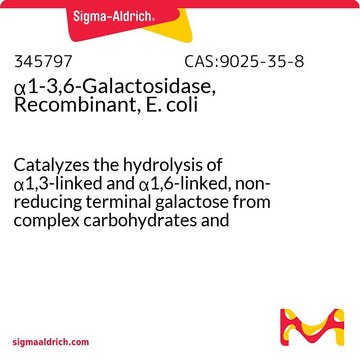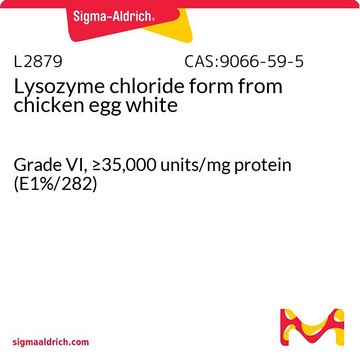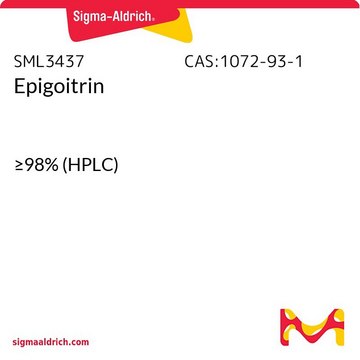T9826
Anti-TGN38 antibody produced in rabbit
~1 mg/mL, affinity isolated antibody, buffered aqueous solution
Synonym(s):
Anti-MGC108592, Anti-TGOLN2, Anti-TTGN1, Anti-Trans-golgi network protein 2
Sign Into View Organizational & Contract Pricing
All Photos(1)
About This Item
Recommended Products
biological source
rabbit
Quality Level
conjugate
unconjugated
antibody form
affinity isolated antibody
antibody product type
primary antibodies
clone
polyclonal
form
buffered aqueous solution
mol wt
antigen ~38 kDa
species reactivity
rat
concentration
~1 mg/mL
technique(s)
indirect immunofluorescence: 5-10 μg/mL using rat NRK cells
shipped in
dry ice
storage temp.
−20°C
target post-translational modification
unmodified
Gene Information
rat ... Tgoln1(192152)
General description
Trans-Golgi network integral membrane protein 2 (TGOLN2), also known as trans-Golgi network 46 (TGN46), is encoded by the gene mapped to human chromosome 2p11.2. It is a heterodimeric type I integral membrane protein. TGOLN2 has a highly conserved N terminus which consists of a signal peptide. The C terminus comprises part of the lumenal domain, a membrane spanning region and cytoplasmic tail.
Specificity
Anti-TGN38 recognizes rat TGN38
Immunogen
Synthetic peptide corresponding to amino acid residues of rat TGN38 with C-terminal added cysteine, conjugated to KLH.
Application
Anti-TGN38 antibody produced in rabbit has been used in immunoblotting and immunocytochemistry.
Anti-TGN38 antibody produced in rabbithas been used in
- immunofluorescence
- western blotting
Biochem/physiol Actions
Trans-Golgi network integral membrane protein 2 (TGOLN2) cycles between the trans-Golgi network (TGN) and the cell surface via an early endosomal compartment. This movement is mediated by a tyrosine-based tetra peptide signal (SDYQRL) in the cytoplasmic domain. It plays an important role in the formation of exocytic vesicles at the TGN by functioning as a receptor for complexes of a cytoplasmic protein known as p62 and one GTP-binding protein. The cytoplasmic domain of TGOLN2 binds to the complex and is essential for budding process. It mediates the coupling of the segregation of secretory proteins to the budding of exocytic vesicles. The cytosolic domain of TGOLN2 interacts with AP2 clathrin adaptor complexes and also with the coiled coil region of a protein called neurabin.
Target description
TGN38 (Trans-Golgi network protein, 38-kDa) is a resident integral membrane protein of the trans-Golgi network (TGN), which cycles constitutively between the TGN and the plasma membrane, returning via endosomes.
Physical form
Solution in 0.01 M phosphate buffered saline, pH 7.4, containing 15 mM sodium azide.
Storage and Stability
For continuous use, store at 2-8 °C for up to one month. For extended storage, freeze in working aliquots. Repeated freezing and thawing, or storage in “frostfree” freezers, is not recommended. If slight turbidity occurs upon prolonged storage, clarify the solution by centrifugation before use. Working dilutions should be discarded if not used within 12 hours.
Disclaimer
Unless otherwise stated in our catalog or other company documentation accompanying the product(s), our products are intended for research use only and are not to be used for any other purpose, which includes but is not limited to, unauthorized commercial uses, in vitro diagnostic uses, ex vivo or in vivo therapeutic uses or any type of consumption or application to humans or animals.
Not finding the right product?
Try our Product Selector Tool.
related product
Product No.
Description
Pricing
Storage Class Code
10 - Combustible liquids
WGK
WGK 3
Flash Point(F)
Not applicable
Flash Point(C)
Not applicable
Personal Protective Equipment
dust mask type N95 (US), Eyeshields, Gloves
Choose from one of the most recent versions:
Already Own This Product?
Find documentation for the products that you have recently purchased in the Document Library.
Our team of scientists has experience in all areas of research including Life Science, Material Science, Chemical Synthesis, Chromatography, Analytical and many others.
Contact Technical Service